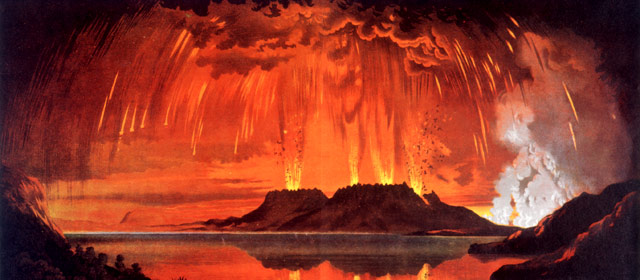He korero whakarapopoto
The Taupō eruption
About 232 CE, before the Polynesian ancestors of Māori arrived in New Zealand, an eruption in the centre of the North Island blasted ash and pumice high into the sky. The enlarged crater it left behind became filled with water, and is today’s Lake Taupō.
Tarawera
The unusual shape of Mt Tarawera formed during eruptions around 1314 CE. Māori may have been living in the area at the time.
The volcano erupted again in June 1886 – the deadliest eruption in the history of New Zealand settlement. Before the eruption, people reported seeing a phantom Māori war canoe on the lake below the volcano. The eruption sent a cloud of lava and ash 10 kilometres high, and destroyed many of the villages in the area. About 120 people were killed.
Tongariro
In 1868, violent earthquakes occurred when Mt Tongariro erupted. This eruption formed the upper Te Maari crater, named after a Māori chieftainess.
Ngāuruhoe
Mt Ngāuruhoe is really part of the Tongariro volcano. It pours out ash about once every six years. There were large eruptions in 1870, in the late 1940s, and in 1954. The most recent eruption was in 1975, when huge blocks of red-hot lava were thrown many kilometres from the mountain.
Ruapehu
The earliest-known eruption of Mt Ruapheu was in 1861. In the late 1800s and early 1900s there were more, some of them forming hot mud flows called lahars. Eruptions of huge clouds of ash in 1945 gave people sore throats and eyes, and smothered crops and farmland. Ash stuck to cars, houses and machinery.
The Tangiwai disaster
In the 1945 eruptions, rubble had built up around Ruapehu’s Crater Lake. In 1953 the rubble collapsed. The lake burst its banks, and the flow of water and rocks that went down the mountain knocked over a railway bridge. A train travelling over the bridge tumbled into the river below, and 151 people were drowned.
Recent volcanic activity
Mt Ruapehu erupted most recently in 1995–96. Mud flowed through the Whakapapa ski field, and the slopes of the mountain were covered with volcanic ash. Whakaari / White Island has twice seen multiple fatalities: 10 people were killed by a debris flow in 1914, and 22 by an eruption in 2019.





